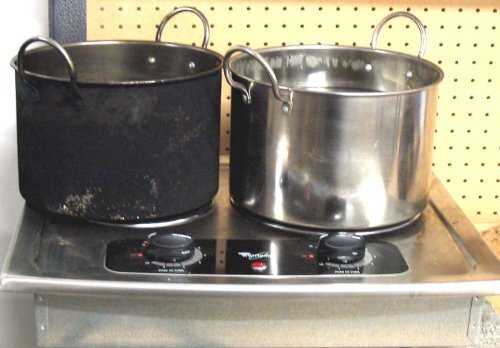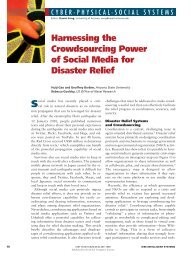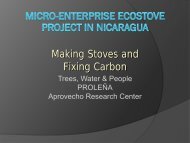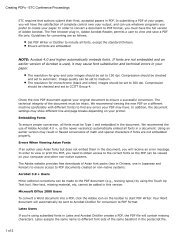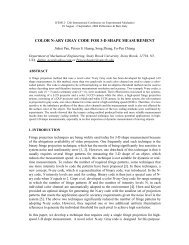Heat Losses In A Cook Pot While Simmering
Heat Losses In A Cook Pot While Simmering
Heat Losses In A Cook Pot While Simmering
Create successful ePaper yourself
Turn your PDF publications into a flip-book with our unique Google optimized e-Paper software.
<strong>Heat</strong> <strong>Losses</strong> <strong>In</strong> A <strong>Cook</strong><br />
<strong>Pot</strong> <strong>While</strong> <strong>Simmering</strong><br />
[ Where Does All That Energy Go?]<br />
by<br />
Dr. Alan Berick<br />
<strong>In</strong>troduction<br />
During simmering or cooking the task of the cook stove is to maintain a constant cooking<br />
temperature in the pot. <strong>In</strong> order to accomplish this goal, enough fuel is used to offset the<br />
energy losses from the pot.<br />
These energy or heat losses are due to three main mechanisms; evaporation, radiation and<br />
convection. The goal of this study is to quantify the relationship of these mechanisms and<br />
to attempt to find means to minimize these losses when possible.<br />
Methods<br />
The pots used in the study are WFP standard pots used in the evaluation of various cook<br />
stove designs. They are pictured in Figure 1. The pots measure 24 cm in diameter and 16<br />
cm in height and are made from stainless steel. They have a capacity of a little more than<br />
7 liters. The tests were all done with 5 liters of water. One of the pots was used in a<br />
number of cook stove tests and its outer surface is blackened with soot. The other has<br />
never been used in testing and has the characteristic shiny surface of a stainless steel pot.
The former is much more likely to be found in a typical third world kitchen. The<br />
expectation is that these pots will have very different heat radiating characteristics and<br />
that is the motivation for using two pots.<br />
All of the tests were done on an electric range rather than a wood-fired cook stove. It is a<br />
much simpler task to hold the pot at a constant temperature on an electric range.<br />
The temperature data was obtained using a thermocouple A/D data logger with an 8<br />
channel capacity. It was a Picolog TC-08 model from Pico Technology Ltd. The data was<br />
fed into a Dell laptop computer with installed software that allowed for tracking the<br />
temperature histories over a variety of preset times and sampling rates. Excel worksheets<br />
were then used in data reduction and for graphing.<br />
Before gathering data some preliminary runs were done with an array of thermocouples<br />
placed in various locations in the experimental pot to see how well they tracked when the<br />
pot was taken from room temperature to boiling. The object was to ascertain if there was<br />
an appreciable distribution of temperatures in the pot during this process. The results<br />
showed that there was a uniformity of temperatures to within one or two tenths of a<br />
degree Celsius throughout the water volume.<br />
Figure 2 shows the results of one of these runs. 5 thermocouples were distributed<br />
vertically in the center of the pot. The top most thermocouple was located one cm below<br />
the top surface while the one at the bottom was positioned one cm above the bottom<br />
surface. The other three were located at 2 cm intervals in between. The Figure shows how<br />
closely they tracked one another. From these results it was decided that a single<br />
thermocouple placed in the center of the pot equidistant from the top and bottom surfaces<br />
of the water would be sufficient for temperature measurements.<br />
Results<br />
The first set of runs were done to quantify the water lost through evaporation at various<br />
fixed liquid temperatures. Runs were made at 10 degree intervals from 50 0 C to 90 0 C and<br />
at 2 degree intervals from 90 0 C to 98 0 C. Figure 3 shows the results in gm/hr of liquid lost<br />
and Figure 4 shows the results in equivalent energy lost in kjoules/hr.<br />
Runs were also made to ascertain the results in evaporation losses when 1) a thin layer of<br />
olive oil was floated on the top surface of the water and 2) a lid was placed on the pot.<br />
These results are shown in Figure 3 for a water temperature of 98 0 C. The olive oil film<br />
was 100% effective in inhibiting the losses due to evaporation while the pot lid was 92%<br />
effective. The latter result was valid as long as the lid was undisturbed during the entire
un. If it were lifted to examine the pot contents or to stir the food, the loss due to<br />
evaporation would be greater.<br />
The effectiveness of the oil film in inhibiting evaporative losses exceeded expectations.<br />
Apparently the oil film forms a potential barrier which the water molecules cannot<br />
penetrate. Any cooking oil or viscous liquid would probably have the same result.<br />
Figure 5 shows temperature histories of a pot taken from room temperature to boiling<br />
with and without an oil film. The run without an oil film has a constant slope until it<br />
reaches temperatures when the losses due to evaporation become significant. At that<br />
point the slope continually decreases in magnitude until it reaches the boiling point. By<br />
comparison the run done with the oil film shows a constant slope until boiling is reached.<br />
The pot with the oil film reaches boiling in 23 min. while the pot without the oil takes 27<br />
min to reach boiling.<br />
Having a means to completely inhibit the evaporation process makes it possible to<br />
quantify the various mechanisms of heat loss during the cooking process. The next part of<br />
the study involved the use of a meter which quantified the amount of electrical energy in<br />
kw-hrs used by the electric range in each experimental run. Runs were made with and<br />
without an oil film with the pot at a constant temperature of 97 0 C. This provided a<br />
relative number for quantifying the heat loss due to evaporation as well as the heat loss<br />
from radiation and convection combined. Next runs were done with an oil film at the<br />
same temperature but in each pot (blackened and shiny). This gave a relative quantity for<br />
the heat loss from radiation since these pots may be expected to have very different<br />
radiation characteristics. Finally if each of these pots can be assigned a coefficient of<br />
radiation which approximates the actual values, then an approximate value for the heat<br />
loss due to radiation can be assigned to each pot and by the process of elimination a value<br />
for the losses due to convection.<br />
For this study a value for the radiation coefficient for the blackened pot of 0.95 and for<br />
the shiny pot of 0.20 was used. <strong>In</strong> addition, since the actual heat loss from radiation is<br />
known from Figure 4, the relative quantities may be assigned actual values. The results<br />
are shown in Figures 6 and 7.<br />
Summary and Conclusions<br />
• At typical cooking temperatures, evaporation accounts for the major portion of the<br />
total heat losses.
• At a temperature of 97 0 C it accounts for approximately 80% of the heat loss.<br />
• A thin layer of cooking oil will entirely eliminate liquid evaporation.<br />
• This not only saves 80% of the fuel used and reduce air pollution by the same<br />
amount, but will also save water. At a cooking temperature of 97 0 C approximately<br />
20% of the water is lost each hour.<br />
• Using a lid while cooking will achieve roughly 90% of the above savings as long<br />
as the lid is not removed during the cook time.<br />
• A shiny pot will reduce the heat loss from radiation but this only amounts to<br />
roughly 5% of the total loss.<br />
• A quick calculation of thermal efficiency for the electric range used in this study<br />
gave a value of 62%.
100<br />
Vertical tc Array in Center<br />
Distance from Bottom<br />
90<br />
80<br />
70<br />
Deg C<br />
60<br />
50<br />
40<br />
30<br />
20<br />
10<br />
0<br />
Fig. 2<br />
148<br />
298<br />
448<br />
598<br />
748<br />
898<br />
1048<br />
Time - sec<br />
1198<br />
1348<br />
1498<br />
1648<br />
1798
CH 1 = 1 cm from bottom<br />
Ch 2 = 3 cm<br />
Ch 3 = 5 cm<br />
Ch4 = 7 cm<br />
Ch 5 = 1 cm from top<br />
1 cm<br />
3 cm<br />
5 cm<br />
7 cm<br />
10 cm<br />
1948
Water Evaporation Rates<br />
1200<br />
1128<br />
1000<br />
954<br />
800<br />
824<br />
gm/hr<br />
600<br />
With Lid<br />
648<br />
706<br />
400<br />
Oil Film<br />
410<br />
200<br />
146<br />
240<br />
74<br />
88<br />
0<br />
0<br />
50.0 60.0 70.0 80.0 90.0 100.0<br />
Fig. 3 Fig. 3<br />
Temp. - Deg. C
Fig. 3
Energy loss from Evaporation<br />
2500<br />
2000<br />
2042<br />
kjoules/hr<br />
1500<br />
1000<br />
1491<br />
1278<br />
1173<br />
1727<br />
742<br />
500<br />
434<br />
134<br />
264
134<br />
0<br />
50.0 60.0 70.0 80.0 90.0 100.0<br />
Temp. - Deg. C<br />
Fig. 4
Comparison of Temp. Histories<br />
120<br />
100<br />
80<br />
Temp. - deg C<br />
60<br />
With Oil<br />
No Oil<br />
40<br />
20<br />
0<br />
Time - sec<br />
Fig. 5
Energy <strong>In</strong>put - 5 Liters of Water<br />
at 97 Deg. C Simmer<br />
3000<br />
kjoules/hr<br />
2500<br />
2000<br />
1500<br />
1000<br />
Blackened <strong>Pot</strong><br />
Shiny <strong>Pot</strong><br />
500<br />
0<br />
No Oil With Oil With Lid<br />
Fig. 6
Energy Loss - 5 Liters of Water<br />
at 97 Deg. C Simmer<br />
kjoules/hr<br />
2000<br />
1800<br />
1600<br />
1400<br />
1200<br />
1000<br />
800<br />
600<br />
400<br />
200<br />
Blackened Po<br />
Shiny <strong>Pot</strong><br />
0<br />
Evaporation<br />
Radiation<br />
Fig. 7
ot<br />
Convection


